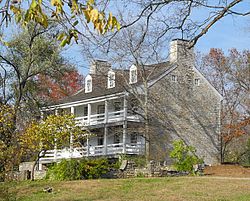
Daniel Boone was an American pioneer and frontiersman whose exploits made him one of the first folk heroes of the United States. Boone became famous for his exploration and settlement of what is now Kentucky, which was then beyond the western borders of the Thirteen Colonies. Despite resistance from American Indians, for whom Kentucky was a traditional hunting ground, in 1775 Boone blazed the Wilderness Road through the Cumberland Gap and into Kentucky. There he founded Boonesborough, one of the first English-speaking settlements west of the Appalachian Mountains. By the end of the 18th century, more than 200,000 people had entered Kentucky by following the route marked by Boone.

Callaway County is a county located in the U.S. state of Missouri. As of the 2020 United States Census, the county's population was 44,283. Its county seat is Fulton. With a border formed by the Missouri River, the county was organized November 25, 1820, and named for Captain James Callaway, grandson of Daniel Boone. The county has been historically referred to as "The Kingdom of Callaway" after an incident in which some residents confronted Union troops during the U.S. Civil War.
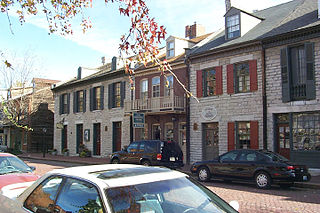
Saint Charles is a city in, and the county seat of, St. Charles County, Missouri, United States. The population was 65,794 at the 2010 census, making St. Charles the ninth-largest city in Missouri. Situated on the Missouri River, St. Charles, Missouri is a northwestern suburb of St. Louis.

Scouting in Missouri has a long history, from the 1910s to the present day.

Fulton is the largest city in and the county seat of Callaway County, Missouri, United States. Located about 22 miles (35 km) northeast of Jefferson City and the Missouri River and 20 miles (32 km) east of Columbia, the city is part of the Jefferson City, Missouri, Metropolitan Statistical Area. The population was 12,790 in the 2010 census. The city is home to two universities, Westminster College and William Woods University; the Missouri School for the Deaf; the Fulton State Hospital; and the Fulton Reception and Diagnostic Center state prison. Missouri's only nuclear power plant, the Callaway Plant is located 13 miles southeast of Fulton.

George Caleb Bingham was an American artist, soldier and politician known in his lifetime as "the Missouri Artist". Initially a Whig, he was elected as a delegate to the Missouri legislature before the American Civil War where he fought against the extension of slavery westward. During that war, although born in Virginia, Bingham was dedicated to the Union cause and became captain of a volunteer company which helped keep the state from joining the Confederacy, and then served four years as Missouri's Treasurer. During his final years, Bingham held several offices in Kansas City, while also serving as Missouri's Adjutant General. His paintings of American frontier life along the Missouri River exemplify the Luminist style.

Lindenwood University is a private university in St. Charles, Missouri. Founded in 1827 by George Champlin Sibley and Mary Easton Sibley as The Lindenwood School for Girls, it is the second-oldest higher-education institution west of the Mississippi River.

Lilburn Williams Boggs was the sixth Governor of Missouri from 1836 to 1840. He is now most widely remembered for his interactions with Joseph Smith and Porter Rockwell, and Missouri Executive Order 44, known by Mormons as the "Extermination Order", issued in response to the ongoing conflict between church members and other settlers of Missouri. Boggs was also a key player in the Honey War of 1837.

Little Dixie is a historic 13- to 17-county region along the Missouri River in central Missouri, United States. Its early Anglo-American settlers were largely migrants from the hemp and tobacco districts of Virginia, Kentucky and Tennessee. They brought enslaved African Americans with them or purchased them as workers in the region. Because Southerners settled there first, the pre-Civil War culture of the region was similar to that of the Upper South. The area was also known as Boonslick country.
Capt. James Callaway (1783–1815), grandson of Daniel Boone. He is the namesake of Callaway County, Missouri.

George Howard Williams was an American politician and attorney from Missouri. A Republican, he served as U.S. Senator from Missouri from 1925 to 1926, completing the term of Selden P. Spencer following the latter's death.
Nathan and Olive Boone Homestead State Historic Site, located two miles north of Ash Grove, Missouri, is a state-owned property that preserves the home built in 1837 by Nathan Boone, the youngest child of Daniel Boone. The Nathan Boone House, which was listed on the National Register of Historic Places in 1969, is a 1+1⁄2-story "classic" saddle-bag pioneer log house, constructed of hand-hewn oak log walls that rest on a stone foundation. Established in 1991, the historic site offers an interpretive trail plus tours of the home and cemetery.

Benjamin Howard was a congressman from Kentucky, the first governor of the Missouri Territory and a brigadier general in the War of 1812.
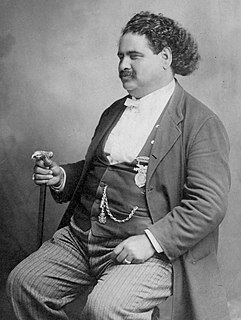
John William "Blind" Boone was an American pianist and composer of ragtime music.
Hamburg was a small town in St. Charles County, Missouri, United States. Hamburg was one of three towns, along with nearby Howell and Toonerville, that were evacuated and terminated in 1940–1941 when the area was taken over by the United States Department of the Army for the Weldon Spring Ordnance Works, which manufactured trinitrotoluene (TNT) and dinitrotoluene (DNT) and later processed uranium.
Rebecca Ann Bryan Boone was an American pioneer and the wife of famed frontiersman Daniel Boone. No contemporary portrait of her exists, but people who knew her said that when she met her future husband she was nearly as tall as he and very attractive with black hair and dark eyes.
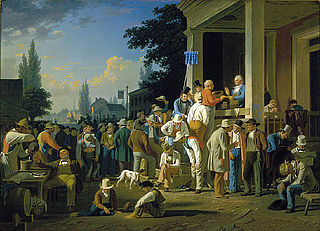
The Boonslick, or Boone's Lick Country, is a cultural region of Missouri along the Missouri River that played an important role in the westward expansion of the United States and the development of Missouri's statehood in the early 19th century. The Boone's Lick Road, a route paralleling the north bank of the river between St. Charles and Franklin, Missouri, was the primary thoroughfare for settlers moving westward from St. Louis in the early 19th century. Its terminus in Franklin marked the beginning of the Santa Fe Trail, which eventually became a major conduit for Spanish trade in the Southwestern United States. Later it connected to the large emigrant trails, including the Oregon and California Trails, used by pioneers, gold-seekers and other early settlers of the West. The region takes its name from a salt spring or "lick" in western Howard County, used by Nathan and Daniel Morgan Boone, sons of famed frontiersman Daniel Boone.

The Boone's Lick Road or Boonslick Trail was an early 1800s transportation route from eastern to central Missouri in the United States. Running east-west on the North side and roughly parallel to the Missouri River the trail began in the river port of St. Charles. The trail played a major role in the westward expansion of the United States and the development of Missouri's statehood. The trail's eventual terminus at Franklin was the start of the better-known Santa Fe Trail. First traced by the sons of Daniel Boone, the path originally ended at a salt lick in Howard County used by the pair to manufacture salt. Today the lick is maintained as Boone's Lick State Historic Site.
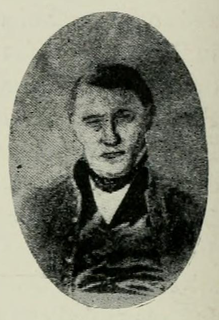
Nathan Boone (1780–1856) was a veteran of the War of 1812, a delegate to the Missouri constitutional convention in 1820, and a captain in the 1st United States Regiment of Dragoons at the time of its founding, eventually rising to the rank of lieutenant colonel. Nathan was the youngest son of Daniel Boone.
Flanders Callaway House was a historic home formerly located near Marthasville, Warren County, Missouri. It was built about 1812, and was a two-story, five-bay, walnut hewn-log frontier house. The house was typical of early Federal style log constructions found in Kentucky and Tennessee. Its builder Flanders Callaway was a son-in-law of Daniel Boone, husband of his second eldest daughter Jemima. Daniel Boone's funeral in 1820 was held in the barn of the Flanders Callaway homestead. The house was completely dismantled in 1968 and sold in 1979 and moved to St. Charles County for reassembly.
